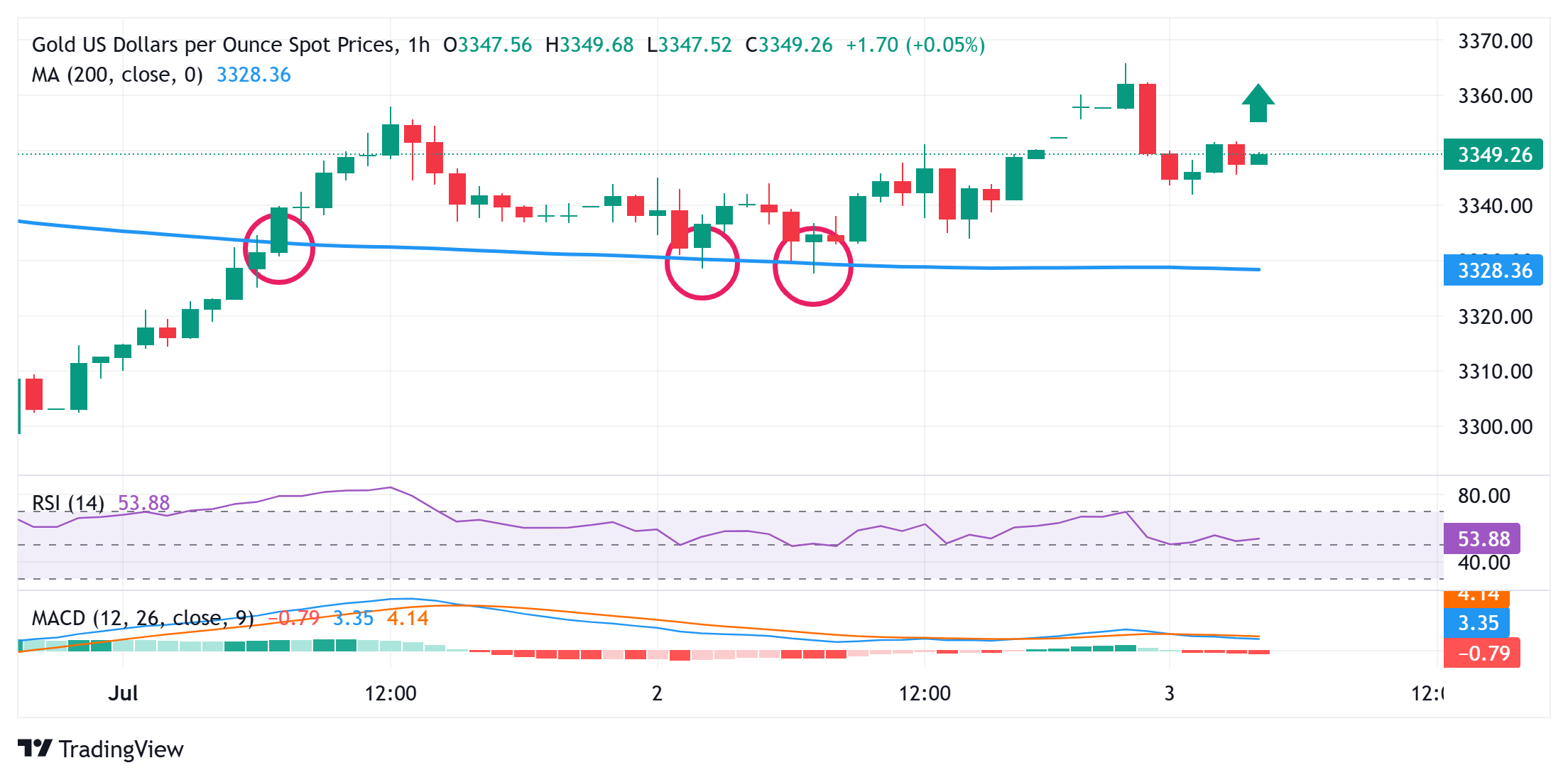- The price of gold goes back from a maximum of more than a week reached during the Asian session.
- A commercial agreement between the US and Vietnam undermines the demand for the precious metal of safe refuge.
- A modest USD rebound also weighs on the merchandise before the US NFP report.
The price of gold (Xau/USD) attracts some vendors during the Asian session on Thursday and, for now, seems to have stagnated a three -day recovery movement from a minimum of one month reached earlier this week. A commercial agreement between the US and Vietnam relieved concerns about prolonged commercial tensions. Apart from this, a modest rebound of the US dollar (USD) turns out to be another factor that exerts some downward pressure on the precious metal of safe refuge. However, any significant depreciation of the merchandise seems elusive in the light of the Dovish expectations of the Federal Reserve (FED).
In fact, operators seem convinced that the US Central Bank will resume its cycle of feat cuts in the near future. The bets were reaffirmed with the disappointing publication of the US ADP report on employment in the private sector on Wednesday. This, together with the concerns that the US fiscal condition could worsen even more after the budget project of President Donald Trump, should limit the USD and support the price of gold. The operators now wait for the US Non -Agricultural Payroll (NFP) report to obtain clues on the path of feat cuts of the Fed and determine the short -term trajectory of the short term of the yellow metal that does not yield.
What moves the market today: the price of gold is pressured by a positive risk tone and a modest rebound of the USD
- President Donald Trump announced Wednesday that the United States has reached a commercial agreement with Vietnam. The US will impose a lower tariff of 20% to the imported goods of the Southeast Asian nation, and the agreement will give the US access without tariffs to the Vietnam markets.
- Meanwhile, US and Indian negotiators are pressing to achieve a tariff reduction agreement before the July 9 deadline imposed by Trump. The developments increase investor confidence and cause some benefits around the price of safe refuge gold after a three -day profit streak.
- However, Trump has not indicated signs of extending the negotiation deadline despite the stagnant conversations with Japan, another key trade partner. This keeps in play the uncertainties related to trade, which, in turn, could continue to offer some precious metal support.
- In the Front of Economic Data, the Automatic Data Processing (ADP) reported that US private payroll fell for the first time in more than two years during June. In fact, employment in the US private sector decreased unexpectedly by 33K compared to the decreased increase in 29k.
- This adds to the report of the Employment and Labor Rotation Survey (Jolts) on Tuesday and underlines a deteriorated trend in the US labor market. In addition, a slow hiring environment could force the Federal Reserve (Fed) to start cutting the interest rates again as soon as this month.
- In fact, operators are currently valuing almost 25% probability of a feat cut by the Fed at the monetary policy meeting of July 29-30. In addition, a 25 basic points cut in September is almost certain, and the expectations of two rate cuts by the end of this year are also high.
- The Fed Dovish expectations should maintain a limit in the attempt to recover the US dollar from a minimum of three and a half years and contribute to limit the losses of the yellow metal that does not yield. Operators could also choose to wait for the publication of the US NFP report.
The alcist technical configuration of the price of gold supports the possibility that purchases arise at lower levels

From a technical perspective, the rupture of this week above the simple mobile average (SMA) of 200 hours was seen as a key trigger for the bulls of the Xau/USD. In addition, the oscillators in the daily chart have begun again to gain positive traction and suggest that the way of lower resistance for the price of gold is upwards. Therefore, any subsequent sliding could still be seen as a purchase opportunity and remain cushioned near the 330-3,329 $ region (SMA of 200 hours). However, a convincing rupture below could cause some technical sales and drag the merchandise more towards the round figure of $ 3,300.
On the other hand, the area of 3,363-3.365 $, or a maximum of more than a week reached on Wednesday, now seems to act as an immediate obstacle, above which the price of gold could aspire to recover the 3,400 $ mark. A sustained strength beyond the latter would deny any short-term negative perspective and raise the Xau/USD torque towards the next relevant obstacle near the 3,435-3,440 $ region.
GOLD – FREQUENT QUESTIONS
Gold has played a fundamental role in the history of mankind, since it has been widely used as a deposit of value and a half of exchange. At present, apart from its brightness and use for jewelry, precious metal is considered an active refuge, which means that it is considered a good investment in turbulent times. Gold is also considered a coverage against inflation and depreciation of currencies, since it does not depend on any specific issuer or government.
Central banks are the greatest gold holders. In their objective of supporting their currencies in turbulent times, central banks tend to diversify their reserves and buy gold to improve the perception of strength of the economy and currency. High gold reserves can be a source of trust for the solvency of a country. Central banks added 1,136 tons of gold worth 70,000 million to their reservations in 2022, according to data from the World Gold Council. It is the largest annual purchase since there are records. The central banks of emerging economies such as China, India and Türkiye are rapidly increasing their gold reserves.
Gold has a reverse correlation with the US dollar and US Treasury bonds, which are the main reserve and shelter assets. When the dollar depreciates, the price of gold tends to rise, which allows investors and central banks to diversify their assets in turbulent times. Gold is also inversely correlated with risk assets. A rebound in the stock market tends to weaken the price of gold, while mass sales in higher risk markets tend to favor precious metal.
The price of gold can move due to a wide range of factors. Geopolitical instability or fear of a deep recession can cause the price of gold to rise rapidly due to its condition of active refuge. As an asset without yield, the price of gold tends to rise when interest rates lower, while the money increases to the yellow metal. Even so, most movements depend on how the US dollar (USD) behaves, since the asset is quoted in dollars (Xau/USD). A strong dollar tends to keep the price of gold controlled, while a weakest dollar probably thrusts gold prices.
Source: Fx Street
I am Joshua Winder, a senior-level journalist and editor at World Stock Market. I specialize in covering news related to the stock market and economic trends. With more than 8 years of experience in this field, I have become an expert in financial reporting.







